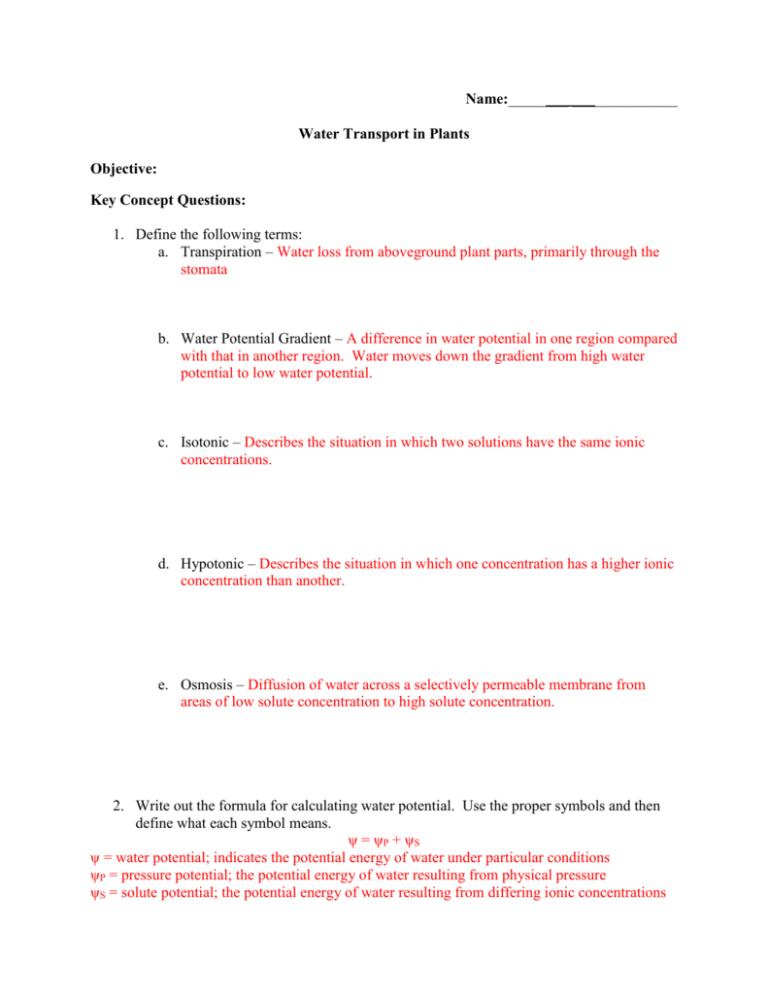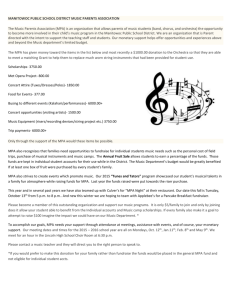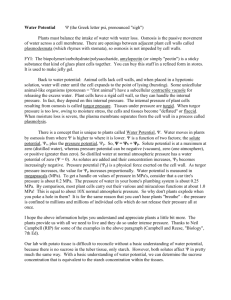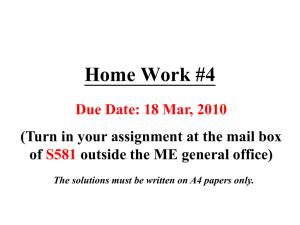Hardy-Weinberg Assignment
advertisement

Name:________ ______________ Water Transport in Plants Objective: Key Concept Questions: 1. Define the following terms: a. Transpiration – Water loss from aboveground plant parts, primarily through the stomata b. Water Potential Gradient – A difference in water potential in one region compared with that in another region. Water moves down the gradient from high water potential to low water potential. c. Isotonic – Describes the situation in which two solutions have the same ionic concentrations. d. Hypotonic – Describes the situation in which one concentration has a higher ionic concentration than another. e. Osmosis – Diffusion of water across a selectively permeable membrane from areas of low solute concentration to high solute concentration. 2. Write out the formula for calculating water potential. Use the proper symbols and then define what each symbol means. ψ = ψP + ψS ψ = water potential; indicates the potential energy of water under particular conditions ψP = pressure potential; the potential energy of water resulting from physical pressure ψS = solute potential; the potential energy of water resulting from differing ionic concentrations 3. Consider the water potential differences in the following situations: a. Water potential in Maryland, a relatively humid area, is -90 MPa. Would it be higher or lower in the desert? Why? Water potential would be lower because the concentration of water vapor in the air would decrease. b. Water potential in a plant with open stomata is -0.4 MPa. Would it be higher or lower when the stomata are closed? Why? Water potential would be higher because the concentration of water in the plant will increase. c. Water potential in wet soil is -1 MPa. Would it be higher or lower in dry soil? Why? Water potential would be lower because the concentration of water in the soil would decrease. Application Questions 4. Describe the direction of water movement in the following situations and give a potential real-world situation where you might see these conditions: a. -100 MPa -0.3 MPa -5.2 MPa In this situation, water would flow out of the plant into the air and soil. This could occur in a desert where both the air and soil is dry. b. -74 MPa -0.6 MPa -0.3 MPa In this situation, water would flow from the soil to the tree to the air, going down the water potential gradient. This situation occurs in most temperate regions where soil moisture is moderate and the air is somewhat humid. 5. In very dry environments, water loss could be a deadly consequence of transpiration. a. How have some plants adapted to limit water loss? Some adaptations to limit water loss are having a thick cuticle, having a thicker epidermis, and having stomata located inside pits. b. Assume you are a plant that needs to increase water loss. How could you accomplish this? If I were a plant wanting to minimize water loss I could always have my stomata open, increase my number of stomata, or have a thin cuticle. 6. If you see a wilting potted plant, what steps could you take to revive the plant? Think of one more step other than watering it (hint – you could change the water potential of the soil, plant and air). Describe how your treatment would affect water potential in the soil, plant, and air. I would water the plant, and then move the plant to a moister climate. In doing so, I would increase the water potential in the soil and increase the water potential of the air just enough to allow the plant to retain some water before transpiration. 7. Tree Species A loses 10 L of water per hour to transpiration and Tree Species B loses 15 L of water per hour to transpiration. a. How much water per day must be taken up by Tree Species A and Tree Species B to account for this water loss (assume each tree is transpiring 12 hours per day)? A – 10L x 12 = 120 L/day B – 15L x 12 = 180 L/day b. What is the minimum amount of water available per day that would allow both trees to survive? The two trees need 300 L/day c. If there is 320 L of water available in the soil each day, can both of these trees survive if they are drawing water from the same soil? Yes, because they only need 300 L/day d. Given that there is not enough water for both trees to survive, and the water potential conditions below, which tree is more likely to survive better (hint – it has nothing to do with size or shape of the tree species)? Why? -25 MPa -25 MPa -0.6 MPa -1.2 MPa -0.1 MPa Species A -0.1 MPa Species B Species B is more likely to survive because water is more likely to flow up its roots. The water potential gradient is larger between the soil and Species B’s roots than the soil and Species A’s roots. 8. Remember that solutes can also affect water potential. In saltwater, soils can often have very low water potentials, making water uptake by roots much harder. Plants will concentrate solutes in their tissues in order to lower the water potential, and allow water to flow from the soil to the root system. a. A black mangrove is located in a salt marsh where the water potential for the soil is -6 MPa. Concentrating 1 mg/L NaCl in plant tissues decreases the water potential of the black mangrove 0.2 MPa. If the water potential in the tree is -0.5 MPa to start with, what is the minimum amount of mg/L NaCl that must be concentrated in the tissues to allow water to flow into the root system? - 6.1 MPa – (-0.5 MPa) = 0.2 MPa/mg/L x XX mg/L NaCl needed -5.6 MPa/0.2 MPa/mg/L = XX mg/L NaCl needed 28 mg/L NaCl = XX b. Na+ and Cl- can also be toxic to plants. If NaCl becomes toxic at 43 mg/L, what is the lowest soil water potential that a black mangrove is capable of offsetting by concentrating NaCl? Remember that the water potential for the plant must be lower than the water potential for the soil. (43 mg/L NaCl x -0.2 MPa/mg/L) – 0.5 MPa = -9.1 MPa Because the water potential must be lower for the plant, the lowest soil water potential that a black mangrove can offset by concentrating NaCl is -9.0 MPa.








